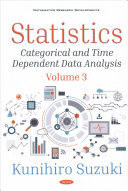Product desciption
Statistics Categorical And Time Dependent Data Analysis Mathematics Research Developments Suzuki by Suzuki, Kunihiro 9781536151244, 1536151246 instant download after payment.
We utilize statistics when we evaluate TV program ratings, predict voting outcomes, prepare stock, predict the amount of sales, and evaluate the effectiveness of medical treatment. We want to predict the results not on the basis of personal experience or images, but on the basis of corresponding data. The accuracy of the prediction depends on the data and related theories. It is easy to show input and output data associated with a model without understanding it. However, the models themselves are not perfect, because they contain assumptions and approximations in general. Therefore, the application of the model to the data should be careful. We should know what model we should apply to the data, what parameters are assumed in the model, and what we can state based on the results of the models.Let us consider a coin toss, for example. When we perform a coin toss, we obtain a head or a tail. If we try the toss a coin three times, we may obtain the results of two heads and one tail. Therefore, the probability that we obtain for heads is , and the one that we obtain for tails is . This is a fact and we need not to discuss this any further. It is important to notice that the probability ( ) of getting a head is limited to this trial. Therefore, we can never say that the probability that we obtain for heads with this coin is , in which we state general characteristics of the coin. If we perform the coin toss trial 400 times and obtain heads 300 times, we may be able to state that the probability of obtaining a head is as the characteristics of the coin. What we can state based on the obtained data depends on the sample number. Statistics gives us a clear guideline under which we can state something is based on the data with corresponding error ranges.Mathematics used in statistics is not so easy. It may be tough work to acquire the related techniques. Fortunately, software development makes it easy to obtain results. Therefore, many members who are not specialists in mathematics can perform statistical analysis with these types of software. However, it is important to understand the meaning of the model, that is, why some certain variables are introduced and what they express, and what we can state based on the results. Therefore, understanding mathematics related to the models is invoked to appreciate the results.In this book, the authors treat models from fundamental ones to advanced ones without skipping their derivation processes. It is then possible to clearly understand the assumptions and approximations used in the models, and hence understand the limitation of the models.The authors also cover almost all the subjects in statistics since they are all related to each other, and the mathematical treatments used in a model are frequently used in the other ones.Additionally, many good practical and theoretical books on statistics are presented [1]-[10]. However, these books are oriented to special cases: Fundamental, mathematical, or special subjects. The author also aims to connect theories to practical subjects. He hopes that this book will aid readers in furthering their knowledge of special cases in statistics.


